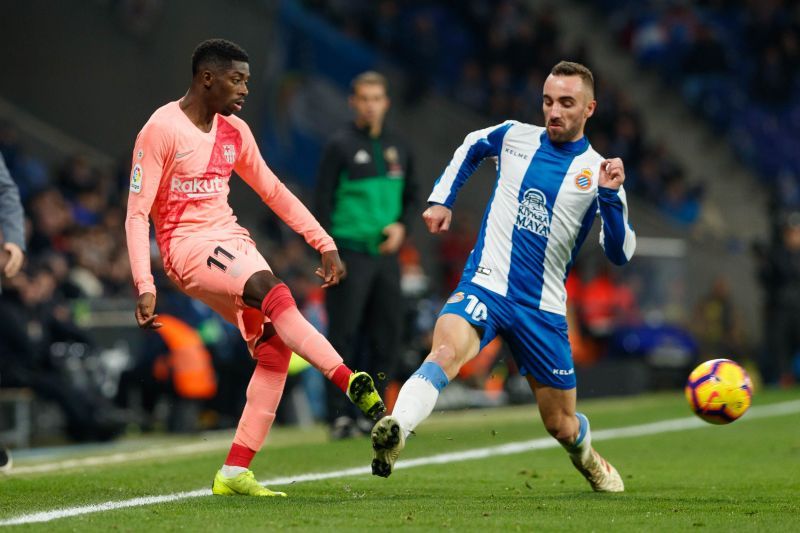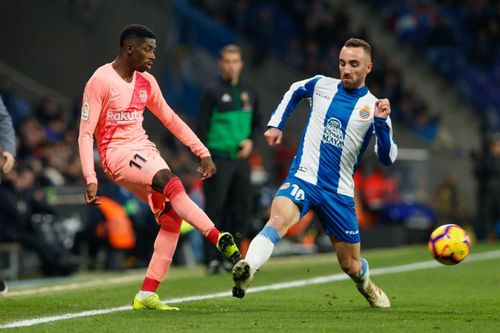
The Catalan Capital lives and breathes Football, and not just on Derby day

While almost everything in the Catalan capital stops whenever its biggest two teams, FC Barcelona and RCD Espanyol, meet in LaLiga action, the city also lives and breathes football 24/7 on the 363 days a year when the derby isn’t being played!
The centre-point of most football fans’ visit to the city will be Barcelona’s Camp Nou or Espanyol’s RCDE Stadium home grounds, whether to take in a match in person or visit their impressive museum and tours.
There is much more football to experience throughout Barcelona, however, and not just on LaLiga match days. Most of the most popular tourist spots have links with one or both of the city’s two biggest football clubs, while visitors who know where to look can learn lots more about the history of both the city and the sport.
1. Las Ramblas / Canaletes
Barcelona’s central Las Ramblas avenue, which links the commercial and shopping areas with the Mediterranean Sea, is an ideal place to soak up the city’s atmosphere on arrival.
Las Ramblas has outlets where you can easily buy Barcelona or Espanyol match tickets, jerseys or souvenirs, while you might also get to meet the ‘Ronaldinho of Las Ramblas,’ a local personality who happily juggles his ball while posing for photos with visitors.
At the city end of Las Ramblas sits the Font de Canaletes, a modest fountain which comes alive whenever Barcelona win a trophy with fans congregating to celebrate into the night. The tradition dates back to the 1930s, when the city’s first sports newspaper La Rambla had its offices right here. The fastest way in those pre-internet days to learn your team’s results was to gather outside and wait for the editors to hang out a blackboard with the score scribbled on. How times change!
A short five-minute walk away is Barça striker Luis Suarez’s ‘Chalito’ restaurant, at Rambla Catalunya, 12, where fans of all clubs are welcome to tuck into South American-inspired fast food.
2. Gaudi, architectural visionary and football fan
Early-20th century visionary Antoni Gaudi is the most celebrated Catalan architect of all time and visitors to Barcelona often visit at least one of the famously unfinished Sagrada Familia cathedral, the magical Parc Guell and the Art Nouveau Casa Vicens museum.
However, few of those visiting his works today will be aware that Gaudi was actually a huge football fan. He loved the game to such an extent that the stadium of the first football team in his Catalan hometown of Riudoms was built on land donated by his family back in 1923.
It is not known if Gaudi attended the very first Catalan derby on record in December 1900, as work was ongoing at the Sagrada Familia site when the teams played out a goalless draw walking distance away at the Camp de l'Hotel Casanovas.
That location is now home to the Hospital de Sant Pau, another striking building from the Catalan Art Nouveau movement, designed by Gaudi’s contemporary Lluis Domenech i Montaner, currently open to the public as a museum and gallery.
3. Diagonal
FC Barcelona’s first-ever game was played in 1899 at the Velodromo de la Bonanova, then a multi-sports ground just outside the city centre. It is now the quiet Turo Parc, a small secluded park close to the bustling Diagonal avenue.
By 1922, Barca had moved further out to Les Corts, the neighbourhood where the Camp Nou stands today. Visitors to the stadium might first stop at the atmospheric Cementerio de Les Cortes, the final resting place of departed Blaugrana heroes including club founder Hans Gamper, Laszlo Kubala, Cesar Rodriguez, Paulino Alcantara and Josep Samitier.
Espanyol also moved around a lot in their early days, playing some of their first games on fields beside the city’s famous ‘Plaza de Toros de las Arenas’ bullring. With interest in bullfighting having fallen in the region over the years, ‘Las Arenas’ has been redeveloped into a multi-use building featuring modern exhibition spaces, an extensive shopping centre, and various restaurants.
4. Montjuic
Overlooking the city of Barcelona is the mountain of Montjuic, with its multi-purpose Estadi Olimpic Lluis Companys which still boasts its beautiful 1920s Art-Nouveau facade.
Montjuic hosted the only Catalan derby Copa del Rey final to date, won 1-0 by Barça in 1957. It was also the main stadium for the 1992 Olympic Games, where soon to be Barça legends Pep Guardiola and Luis Enrique, as well as future Espanyol left-back Jose Emilio Amavisca, won gold in the final of the football tournament.
Espanyol called the 60,000-seater stadium home between 1997 and 2009, celebrating many special nights there including the club’s 100th anniversary, before moving to the RCDE Stadium in the city’s suburbs.
The Estadi Olimpic now regularly hosts American football, rugby and athletics events, as well as music concerts from top international acts such as Bruce Springsteen and Coldplay. It can be visited for free most days of the year and the stunning views of the city and the sea from the top of the hill alone merit the climb up.
Montjuic is also home to the Pompeya tennis club, whose restaurant witnessed one of the most famous moments in Blaugrana history back in December 2000 when former player-turned-director Charly Rexach wrote out a first contract for then-12-year-old Lionel Messi on the back of a napkin. The rest, as they say, is history.
5. To the beach for a game
The easiest way back to the centre from Montjuic is to take the cable car down to the Barceloneta port area. From there it’s just a raking Sergio Busquets or Esteban Granero diagonal ball to the beach, another of the city’s must-visit places.
Further along the water, past the Parc de la Ciutadella and the Casino, is the Bogatell beach, where permanent goalposts are fixed into the sand just waiting for impromptu games of beach football to break out.
Also down by the seafront is Blue Spot, a bar restaurant on Passeig Joan de Borbo, whose investors include Barça defender Gerard Pique and his partner Shakira.